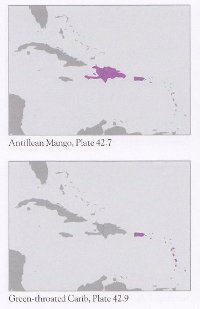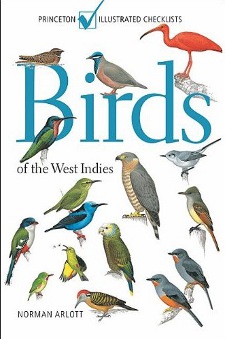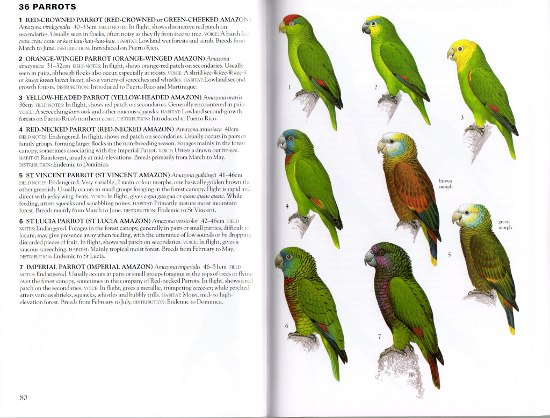Reviewed by Grant McCreary on April 19th, 2011.
When I plan birding vacations, many things factor into the decision on where to go. I want to maximize the number of birds I see, of course, so number of possible species is very important. But it’s not just quantity; quality also plays a part. I’m reluctant to talk about birds in this way, as no species is necessarily inherently “better” than another. But it’s just a fact that certain birds possess qualities that make them more desirable to birders. Some of these qualities are spectacular physical appearance, unique behavior, rarity, and a restricted range.
It’s with this in mind that I’m surprised the Caribbean seems to be overlooked by most traveling birders. A trip to this region will not yield a long bird list (indeed, an extended stay on even one of the larger islands may not break 100 species). But what it lacks in quantity it sure makes up in quality. You want spectacular birds? Just wait until you see a tropicbird or one of the diminutive todies. Rarity? Unfortunately, all too many island species are threatened. And many of the Caribbean islands host one or more birds found only there. To see what I mean, one just has to crack open a field guide to the region, such as Birds of the West Indies, by Norman Arlott.
Birds of the West Indies includes all the birds recorded in the three major Caribbean island groups: the Bahamas, Greater Antilles, and Lesser Antilles, as well as San Andrés and Providencia. As a part of the Princeton Illustrated Checklist series, this is a compact, little book. Contrary to the series’ name, however, this is more than a mere checklist with pictures. It follows a standard field guide format, with the illustration plates on the right and species accounts on the facing page.
Illustrations
This field guide is illustrated with paintings by Arlott. They’re not only accurate (which is the most important thing), but I find them very attractive as well. The concise format means that not all plumages were included. Most male/female and breeding/non-breeding plumages are displayed, though not for all the warblers. Some examples of geographic variation are included, which is very important in this region. However, no immatures are illustrated, which could cause a huge problem with some birds. Immature night-herons, for example, would be impossible to differentiate using this guide. The only birds shown in flight are seabirds (only in flight), raptors, gulls, swifts (only in flight), and swallows. Oddly, the terns are only shown perched.
Personally, I’m frustrated by the use of numbers to label the species. This is a common convention in field guides that have to stuff many birds on each plate (such as those for the neotropics). But most of these pages are not very crowded, so I would have preferred them to be labeled with the species name instead. I find it annoying to have to constantly look back and forth to find out what bird I’m looking at.
Species Accounts
The text accounts include:
- Size – length in centimeters
- Field Notes – behavior, and description of any subspecies
- Voice
- Habitat
- Distribution
The “Field Notes” focus on behavioral traits that may be important for identification. Occasionally, field marks are mentioned that may not be evident in the illustrations, and descriptions of juveniles and subspecies are given where appropriate. I appreciate the inclusion of behavior (an important aspect that many field guides don’t address), but I’m disappointed that it does not give tips on how to differentiate between similar species, leaving you to decipher that yourself from the plates. This would be a major drawback in a field guide for any other region, but less so here. The Caribbean region doesn’t have as many confusing species as most places. Still, while using this guide to prepare for a recent trip there, I found this to be a recurring annoyance.
Voice and Habitat are just what you would expect. In most cases, the Distribution section just notes the island(s) the bird is found on and, in the case of migrants, when. Abundance status is given for some, but unfortunately not all.
Range Maps
 Range maps are an essential component of a field guide. Usually. But for this region, they’re really not necessary for most birds, with the exception of seabirds and some single-island endemics. For the rest, the distribution section in the account should suffice. However, this guide includes a range map for most every species, gathered together in a separate section in the back of the book with eight two-inch-wide maps per page. I wouldn’t complain about what is essentially a bonus, if only they were handled better. For most species, the map only shows whether it is present on the island, not necessarily where it actually occurs on that island. Further, every map uses the same scale that shows the entire region. As a result, many maps are zoomed too far out to be of use for the smaller islands (the two smaller Cayman Islands can’t be seen at all). Using an appropriate scale would have allowed the maps to be much more detailed and useful. Finally, while the maps include the plate number where you can find the bird, the species accounts inexcusably do not indicate where to find the map. A page or map number should have been included in the accounts.
Range maps are an essential component of a field guide. Usually. But for this region, they’re really not necessary for most birds, with the exception of seabirds and some single-island endemics. For the rest, the distribution section in the account should suffice. However, this guide includes a range map for most every species, gathered together in a separate section in the back of the book with eight two-inch-wide maps per page. I wouldn’t complain about what is essentially a bonus, if only they were handled better. For most species, the map only shows whether it is present on the island, not necessarily where it actually occurs on that island. Further, every map uses the same scale that shows the entire region. As a result, many maps are zoomed too far out to be of use for the smaller islands (the two smaller Cayman Islands can’t be seen at all). Using an appropriate scale would have allowed the maps to be much more detailed and useful. Finally, while the maps include the plate number where you can find the bird, the species accounts inexcusably do not indicate where to find the map. A page or map number should have been included in the accounts.
Consistent with the plan to make this guide as compact as possible, the introduction is a very succinct four pages. Along with brief notes on how to use the book, there are a couple of bird topography diagrams and a nice, full-page, color map of the region covered.
Comparison to Other Guides
Prior to this Illustrated Checklist, the preeminent field guide to the Caribbean was the identically titled Birds of the West Indies, by Herbert Raffaele et al. The format of the two books is largely the same, though Raffaele includes maps for only selected species alongside the text accounts. I much prefer Arlott’s illustrations; I find the look of some birds in the other to be “off” somehow, especially the warblers and shorebirds. However, Raffaele does show more variation and the text includes more identification information.
Recommendation
I would highly recommend Birds of the West Indies to anyone visiting the Caribbean, even a single island that has a good guide of its own (i.e. Jamaica). So the only question remains which Birds of the West Indies – Arlott or Raffaele?
Actually, the answer may be both. Honestly, I don’t think either one is completely adequate by itself. Arlott has gaps in the illustrations and is deficient when it comes to difficult identifications, while Raffaele’s poorer illustrations (in my mind) requires a North American field guide as a supplement for shared species. I took both on a recent Caribbean vacation. I found myself referring most to the Illustrated Checklist, which came with me while Raffaele stayed in the room. That was a good arrangement, though I think the best combination would be Arlott’s field guide and Raffaele’s A Guide to the Birds of the West Indies, an older, larger reference on which his field guide is based. That way you would have Arlott’s superior art and behavioral notes, while Raffaele’s book rounds out the illustrations and helps with confusing species by way of its expanded text.
But that’s an expensive arrangement. If I were forced to choose just one for birding in the Caribbean – or for Florida birders hoping for a vagrant – I’d have to go with Raffaele’s Birds of the West Indies.
Disclosure: I get a small commission for purchases made through links in this post.
Disclosure: The item reviewed here was a complementary review copy provided by the publisher. But the opinion expressed here is my own, it has not been influenced in any way.






Comment